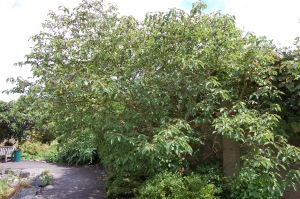Position: Full sun to partial shade
Soil: Well drained soil
Flowering period: Spring
Eventual Height: 9m
Eventual Spread: 9m
Hardiness: 7a, 7b, 8a, 8b, 9a, 9b, 10a, 10b, 11a
Family: Moraceae
Broussonetia papyriferas is a deciduous tree with a compact, round-headed habit. Its serrate, olive-green leaves can vary from un-lobed to deeply lobed even on the same branch, they are rough above and greyish and pubescent below. The inflorescence is dioecious and the plants themselves are either male or female. The flowers on the male plants are oblong catkins with the females being purple and globose. In summer the female plants will produce a spherical syncarp composed of orange-red drupelets which are edible.
Broussonetia papyriferas, commonly known as the Paper Mulberry, is native to much of eastern Asia and has been naturalised in parts of Europe, the Middle East and south-eastern North America where it is considered an invasive plant. In China it was traditionally used for making paper and in Polynesia for making a cloth called tapa.
The etymological root of the binomial name Broussonetia was named for Pierre Marie Auguste Broussonet, an 18th century French naturalist. Papyrifera is derived from the Latin papyrus, a plant which was the main source of paper and fera also Latin, meaning ’wild’.
The landscape architect may find Broussonetia papyriferas useful as a small ornamental tree which is attractive to birds for its fruit.. Care should be taken when locating this tree as its roots are extremely aggressive when seeking water and may cause problems with drainage pipes. This plant is an invasive species in parts of the US, South Asia and Latin America.
Broussonetia papyriferas will tolerate almost any soil conditions; it will be happy in neutral, acid or alkaline pH levels, in loam, clay or sand based soils facing any aspect, either sheltered or exposed. It will prefer very well drained soil and is highly tolerant to urban pollution.
Ecologically, Broussonetia papyriferas will attract pollinating insects such as butterflies and honey bees. The sweet fruit will also attract animals. Although as it is not native to this continent these associations will not be prolific.
Broussonetia papyriferas requires little to no maintenance. Dead or damaged material may be removed in winter.







Hello! I just want to make a enormous thumbs up with the great info you’ve here during this post. We are returning to your blog for additional soon.